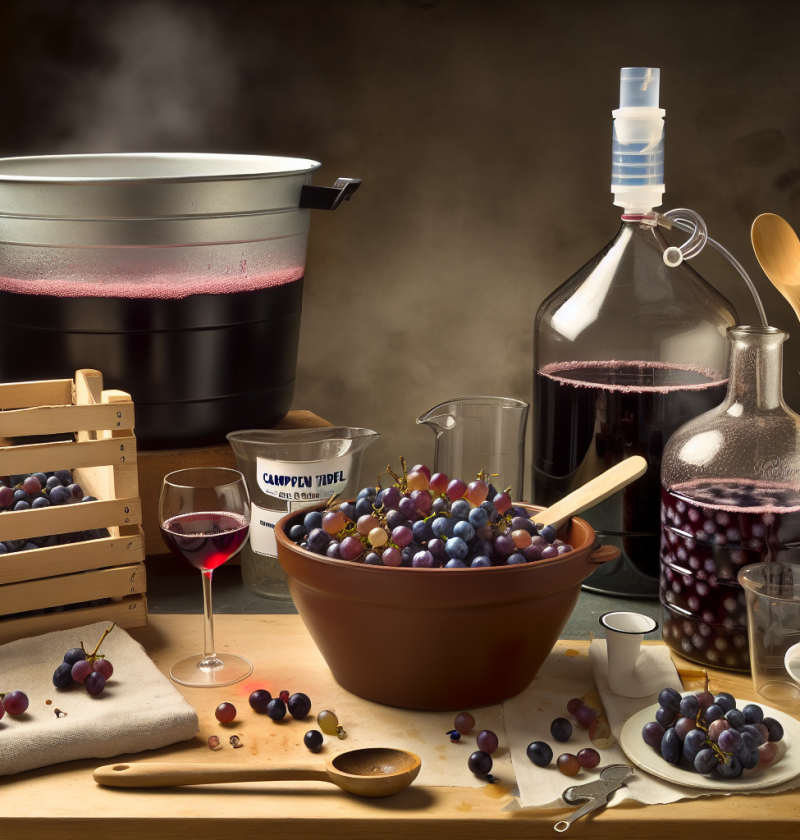The Secret to Perfect Homebrew: Muscadine Wine Recipe Revealed!
Have you ever dreamed of crafting an exquisite wine that will dazzle your taste buds and leave your guests asking for more? Imagine a wine so rich, so robust, and so delicious that you’ll never want to buy a bottle from the store again. From personal experience, I can tell you that making muscadine wine at home is not only simple but also incredibly rewarding. Join me as I share the secrets to creating a sensational homemade muscadine wine that you’ll cherish for years to come.
Preparation Time
- Preparation: 30 minutes
- Fermentation: 1-2 weeks
- Aging: 6-12 months
This recipe serves around 4-5 bottles and is moderately easy to prepare. Let’s get started!
Ingredients
The necessary ingredients (possible in all kinds of variations)
- 6 pounds of muscadine grapes
- 6 cups of granulated sugar
- 1 package of wine yeast
- 1 gallon of filtered water
- 1 Campden tablet (optional, for sterilization)
- 1 teaspoon of pectic enzyme
- 1 teaspoon of yeast nutrient
For those looking to adapt, consider vegan wine yeast or organic sugar for a healthier alternative.
Steps
The steps of preparation (possible in all kinds of variations)
- First and foremost, wash the muscadine grapes thoroughly.
- Crush the grapes in a large container, ensuring the skin breaks open to release the juices.
- Add the crushed grapes and their juices into a fermentation bucket.
- In a separate pot, dissolve the sugar in the filtered water over medium heat. Stir until fully dissolved.
- Once cooled, pour the sugary water into the fermentation bucket with the grapes.
- Add the Campden tablet, pectic enzyme, and yeast nutrient to the mix. Stir well.
- Cover the bucket with a cloth and let it sit for 24 hours to sterilize and settle.
- After 24 hours, sprinkle the wine yeast on top of the mixture.
- Cover the bucket again and let it ferment for about a week, stirring daily.
- After the fermentation period, strain the liquid into a glass carboy, discarding the solids.
- Seal with an airlock and let it ferment further for another 2 weeks.
- Once fermentation slows, rack the wine, which means transferring it to another carboy, leaving the sediment behind.
- Seal with an airlock and let the wine age for 6-12 months in a cool, dark place.
- Bottle the wine once it’s finished aging, and enjoy!
This comprehensive guide should help you through the process, whether you’re a newcomer or an experienced homebrewer. Remember, patience is key – great wine takes time!
Nutritional Benefits
- Rich in antioxidants, particularly resveratrol, which is good for heart health.
- High in vitamins C and K, beneficial for immune support and bone health.
- Muscadines contain dietary fiber that aids in digestion.
- Including natural sugars, produces a balanced and flavorful wine.
Beyond its delightful taste, muscadine wine offers a plethora of health benefits that make the experience of drinking it even better!
Possible Additions or Upgrades
- Consider adding oak chips during aging for a more complex flavor.
- Experiment with different yeast strains to influence the taste profile.
- Add a blend of fruits like strawberries or blueberries for a unique twist.
- Incorporate spices like cinnamon or nutmeg for a warm, aromatic note.
There are numerous ways to enhance the flavor and complexity of your muscadine wine, making every batch a new adventure.
Questions and Answers
Can I use store-bought muscadine grapes?
Yes, but fresh, locally sourced grapes offer the best flavor.
Do I need to sterilize all equipment?
Absolutely. Sterilization prevents unwanted bacteria and ensures a clean fermentation process.
How do I know when the wine is ready?
When fermentation slows and the wine has aged for a minimum of 6 months, it should be ready for bottling.
Can I make this wine without added sugar?
You can, but the resulting wine will be less sweet and may have a weaker flavor.
What’s the role of pectic enzyme?
Pectic enzyme helps to break down the fruit, releasing more juice and reducing haze in the finished wine.
What should I do if my wine isn’t fermenting?
Check the temperature and make sure it’s in the ideal range for the yeast strain you’re using.
Can I reuse the wine yeast?
Reusing yeast is not recommended as it can affect the quality and consistency of the wine.
How do I store the wine during aging?
Keep your wine in a cool, dark place to allow it to age properly without exposure to sunlight or fluctuations in temperature.
Is there a way to speed up the aging process?
Oak chips can slightly speed up the aging process, but there’s no substitute for time.
What is racking and why is it important?
Racking is the process of transferring wine to a clean container to leave sediment behind, resulting in clearer, purer wine.
I hope you enjoy this journey of making muscadine wine as much as I do! There’s nothing quite like the satisfaction of sipping on a wine crafted by your own hands. If you loved this recipe, be sure to share it on social media and spread the joy of home winemaking with your friends and family!







